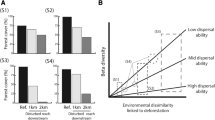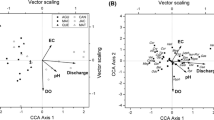Abstract
Biotas from all ecosystems need to respond to factors that determine habitat suitability. These factors originate from different scales. Effects can be assumed to be hierarchical in the order large-scale geographic > regional > local > small-scale in-habitat factors. We aimed at the identification of general patterns by comparisons between ecosystems (forest floor snails, hololimnic stream macroinvertebrates) and across scales, and include potential seasonal effects. Sampling sites displayed signs of naturalness, such as high levels of deadwood accumulation in the forests, or a lack of artificial stream bed fixation plus a “good” to “high” score for the assemblage-derived Multimetric Index (MMI) in the streams. Terrestrial and aquatic assemblages of non-emergent taxa fluctuated independent of seasonal effects. They differed in their relative correlation with environmental matrices with quasi-concentric effects in forests, and longitudinal effects in streams. Large-scale factors, namely geographic position, strongly influenced assemblage turnover, but the effect is based on a high covariation between geographic position and environmental factors. We thus extracted variables that best explained species turnover after correcting for spatio-temporal effects. The terrestrial community assembling was habitat-based and mainly responded to soil acidification, distance to disturbances, and regional scale deforestation and deciduous/mixed forest cover. The stream assemblages were structured by regional pasture cover, organic pollution, regional deciduous forest cover and microlithal cover. Apparently, community assembly occurs along with changes in regional forest cover and the transport of nutrients and matter that can originate from a distance, irrespective of ecosystem and assumed “naturalness”.




Similar content being viewed by others
References
Alewell C, Armbruster M, Bittersohl J, Evans CD, Meesenburg H, Moritz K, Prechtel A (2002) Are there signs of acidification reversal in freshwaters of the low mountain ranges in Germany? Hydrol Earth Syst Sci 5:367–378
Allan JD (2004) Landscapes and riverscapes: the influence of land use on stream ecosystems. Ann Rev Ecol 35:257–284
Basterretxea G, Tovar-Sanchez A, Beck AJ, Masqué P, Bokuniewicz HJ, Coffey R, Duarte CM, Garcia-Orellana J, Garcia-Solsona E, Martinez-Ribes L, Vaquer-Sunyer R (2010) Submarine groundwater discharge to the coastal environment of a Mediterranean island (Majorca, Spain): ecosystem and biogeochemical significance. Ecosystems 13:629–643
Bengtsson J, Nilsson SG, Ås S (1995) Non-random occurrence of threatened land snails on forest islands. Biodiv Lett 2:140–148
Böhmer J, Rawer-Jost C, Zenker A, Meier C, Feld C, Biss R, Hering D (2004) Assessing streams in Germany with benthic invertebrates: development of a multimeric invertebrate based assessment system. Limnologica 34:416–432
Bond NR, Lake PS (2003) Local habitat restoration in streams: constraints on the effectiveness of restoration for stream biota. Ecol Manag Restor 4:193–198
Borcard D, Legendre P, Drapeau P (1992) Partialling out the spatial component of ecological variation. Ecology 73:1045–1055
Boulton AJ, Findlay S, Marmonier P, Stanley EH, Valett HM (1998) The functional significance of the hyporheic zone in streams and rivers. Ann Rev Ecol 29:59–81
Briers RA, Gee JHR (2004) Riparian forestry management and adult stream insects. Hydrol Earth Syst Sci 8:545–549
Brosse S, Arbuckle CJ, Townsend CR (2003) Habitat scale and biodiversity: influence of catchment, stream reach and bedform scales on local invertebrate diversity. Biodiv Cons 12:2057–2075
Ellis J, Schneider DC (2008) Spatial and temporal scaling in benthic ecology. J Experim Marine Biol Ecol 366:92–98
European Environmental Agency (2002) Ecoregions for rivers and lakes. www.eea.europa.eu/data-and-maps. Accessed 16 September 2010
European Environmental Agency (2009) Biogeographical regions in Europe. www.eea.europa.eu/data-and-maps. Accessed 16 September 2010
Finzi AC, Canham CD, Van Breemen N (1998) Canopy tree-soil interactions within temperate forests: species effects on pH and cations. Ecol Appl 8:447–454
Furse M, Hering D, Moog O, Verdonschot PFM, Sandin L, Brabec K, Gritzalis K, Buffagni A, Pinto P, Friberg N, Murray-Bligh J, Kokes J, Alber R, Usseglio-Polatera P, Haase P, Sweeting R, Bis B, Szoszkiewicz K, Soszka H, Springe G, Sporka F, Krno I (2006) The STAR project: context, objectives and approaches. Hydrobiologia 566:3–29
Götmark F, von Proschwitz T, Franc N (2008) Are small sedentary species affected by habitat fragmentation? Local vs. landscape factors predicting species richness and composition of land molluscs in Swedish conservation forests. J Biogeogr 35:1062–1076
Haase P, Lohse S, Pauls S, Schindehuette K, Sundermann A, Rolauffs P, Hering D (2004a) Assessing streams in Germany with benthic invertebrates: development of a practical standardised protocol for macroinvertebrate sampling and sorting. Limnologica 34:349–365
Haase P, Pauls S, Sundermann A, Zenker A (2004b) Testing different sorting techniques in macroinvertebrate samples from running waters. Limnologica 34:366–378
Hancock PJ (2002) Human impacts on the stream-groundwater exchange zone. Environ Manag 29:763–781
Harding JS, Benfield EF, Bolstad PV, Helfman GS, Jones EBD (1998) Stream biodiversity: the ghost of land use past. Proc Natl Acad Sci USA 95:14843–14847
Hering D, Buffagni A, Moog O, Sandin L, Sommerhaeuser M, Stubauer I, Feld C, Johnson R, Pinto P, Skoulikidis N, Verdonschot P, Zahradkova S (2003) The development of a system to assess the ecological quality of streams based on macroinvertebrates—design of the sampling programme within the AQEM project. Int Rev Hydrobiol 88:345–361
Hylander K, Nilsson C, Jonsson BG, Goethner T (2005) Differences in habitat quality explain nestedness in a land snail meta-community. Oikos 108:351–361
Kappes H (2006) Relations between forest management and slug assemblages (Gastropoda) of deciduous regrowth forests. Forest Ecol Manag 237:450–457
Kappes H, Catalano C, Topp W (2007) Coarse woody debris ameliorates chemical and biotic soil parameters of acidified broad-leaved forests. Appl Soil Ecol 36:190–198
Kappes H, Jordaens K, Hendrickx F, Maelfait J-P, Lens L, Backeljau T (2009a) Response of snails and slugs to fragmentation of lowland forests in NW Germany. Landsc Ecol 24:685–697
Kappes H, Jordaens K, Van Houtte N, Hendrickx F, Maelfait J-P, Lens L, Backeljau T (2009b) A land snail’s view of a fragmented landscape. Biol J Linn Soc 98:839–850
Kappes H, Sundermann A, Haase P (2010) High spatial variability biases the space-for-time approach: implications of hidden trends for environmental assessment. Ecol Indic 10:1202–1205
Kauffman JB, Krueger WC (1984) Livestock impacts on riparian ecosystems and streamside management implications: a review. J Range Manag 37:430–438
Legendre P, Gallagher ED (2001) Ecologically meaningful transformations for ordination of species data. Oecologia 129:271–280
Lemly AD (1982) Modification of benthic insect communities in polluted streams: combined effects of sedimentation and nutrient enrichment. Hydrobiologia 87:229–245
Leuven RSEW, van der Velde G, Baijens I, Snijders J, van der Zwart C, Lenders HJR, bij de Vaate A (2009) The river Rhine: a global highway for dispersal of aquatic invasive species. Biol Invasions 11:1989–2008
Levin SA (2000) Multiple scales and the maintenance of biodiversity. Ecosystems 3:498–506
Likens GE, Bormann FH (1974) Linkages between terrestrial and aquatic ecosystems. Bioscience 24:447–456
Martin K, Sommer M (2004) Relationships between land snail assemblage patterns and soil properties in temperate-humid forest ecosystems. J Biogeogr 31:531–545
Martinson L, Lamersdorf N, Warfvinge P (2005) The solling roof revisited–slow recovery from acidification observed and modeled despite a decade of “clean-rain” treatment. Environ Pollut 135:293–302
MCPFE (2003) Improved pan-European indicators for sustainable forest management. In: Ministerial conference on the protection of forests in Europe (MCPFE). Liaison Unit Vienna, Vienna
Mokany K, Richardson AJ, Poloczanska ES, Ferrier S, The CSIRO CAF Biodiversity Working Group (2010) Uniting marine and terrestrial modelling of biodiversity under climate change. Trends Ecol Evol 25:550–551
MURL (1989) Klima-Atlas von Nordrhein-Westfalen Raumordnung und Landwirtschaft des Landes NRW. Ministerium für Umwelt, Düsseldorf
Mykrä H (2008) Predicting the stream macroinvertebrate fauna across regional scales: influence of geographical extent on model performance. J N Am Benthol Soc 27:705–716
Mykrä H, Heino J, Muotka T (2004) Variability of lotic macroinvertebrate assemblages and stream habitat characteristics across hierarchical landscape classifications. Environ Manag 34:341–352
Nekola JC (2010) Acidophilic terrestrial gastropod communities of North America. J Moll Stud 76:144–156
Palmer MA, Ambrose RF, Poff LN (1997) Ecological theory and community restoration ecology. Restor Ecol 5:291–300
Richards C, Johnson LB, Host GE (1996) Landscape-scale influences on stream habitats and biota. Can J Fisheries Aquat Sci 53(Suppl. 1):295–311
Sandin L (2009) The effects of catchment land-use, near-stream vegetation, and river hydromorphology on benthic macroinvertebrate communities in a south-Swedish catchment. Fundam Appl Limnol/Arch Hydrobiol 174:75–87
Stoddard JL, Jeffries DS, Lukewille A, Clair TA, Dillon PJ, Driscoll CT, Forsius M, Johannessen M, Kahl JS, Kellogg JH (1999) Regional trends in aquatic recovery from acidification in North America and Europe. Nature 401:575–578
Strayer DL, Beighley RE, Thompson LC, Brooks S, Nilsson C, Pinay G, Naiman RJ (2003) Effects of land cover on stream ecosystems: roles of empirical models and scaling issues. Ecosystems 6:407–423
Suominen O, Edenius L, Ericsson G, Resco de Dios V (2003) Gastropod diversity in aspen stands in coastal northern Sweden. Forest Ecol Manag 175:403–412
Townsend CR, Doledec S, Norris R, Peacock K, Arbuckle C (2003) The influence of scale and geography on relationships between stream community composition and landscape variables: description and prediction. Freshw Biol 48:768–785
Turner MG (1989) Landscape ecology: the effect of pattern on process. Ann Rev Ecol Syst 20:171–197
Van De Koppel J, Bardgett RD, Bengtsson J, Rodriguez-Barrueco C, Rietkerk MG, Wassen MJ, Wolters V (2005) The effects of spatial scale on trophic interactions. Ecosystems 8:801–807
Vandewalle M, de Bello F, Berg MP, Bolger T, Dolédec S, Dubs F, Feld CK, Harrington R, Harrison PA, Lavorel S, da Silva PM, Moretti M, Niemelä J, Santos P, Sattler T, Sousa JP, Sykes MT, Vanbergen AJ, Woodcock BA (2010) Functional traits as indicators of biodiversity response to land use changes across ecosystems and organisms. Biodiv Cons 19:2921–2947
Wall DH, Palmer MA, Snelgrove PVR (2001) Biodiversity in critical transition zones between terrestrial, freshwater, and marine soils and sediments: processes, linkages, and management implications. Ecosystems 4:418–420
Webster JR, Benfield EF (1986) Vascular plant breakdown in freshwater ecosystems. Ann Rev Ecol 17:567–594
Acknowledgments
This work was financially supported by the research funding programme “LOEWE -Landes-Offensive zur Entwicklung Wissenschaftlich-ökonomischer Exzellenz” of Hesse’s Ministry of Higher Education, Research, and the Arts. Sami Domisch kindly helped with the extraction of the CLC data.
Author information
Authors and Affiliations
Corresponding author
Rights and permissions
About this article
Cite this article
Kappes, H., Sundermann, A. & Haase, P. Distant land use affects terrestrial and aquatic habitats of high naturalness. Biodivers Conserv 20, 2297–2309 (2011). https://doi.org/10.1007/s10531-011-0089-x
Received:
Accepted:
Published:
Issue Date:
DOI: https://doi.org/10.1007/s10531-011-0089-x




